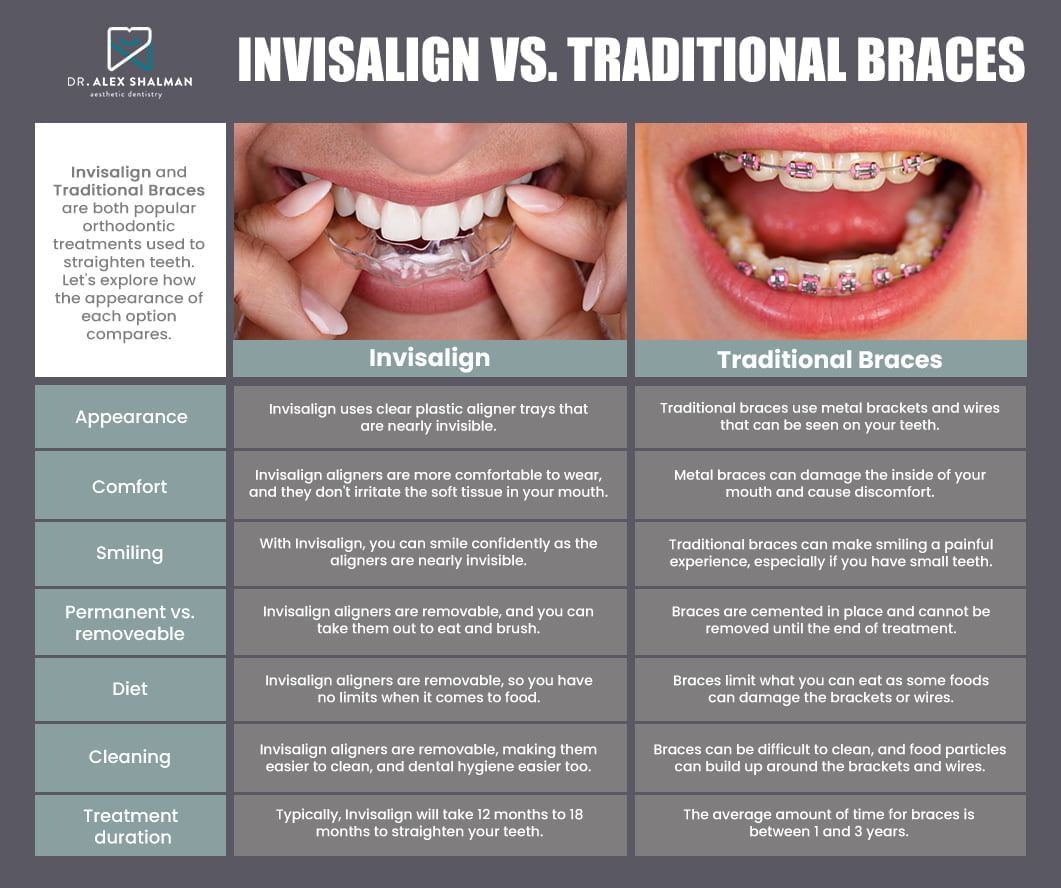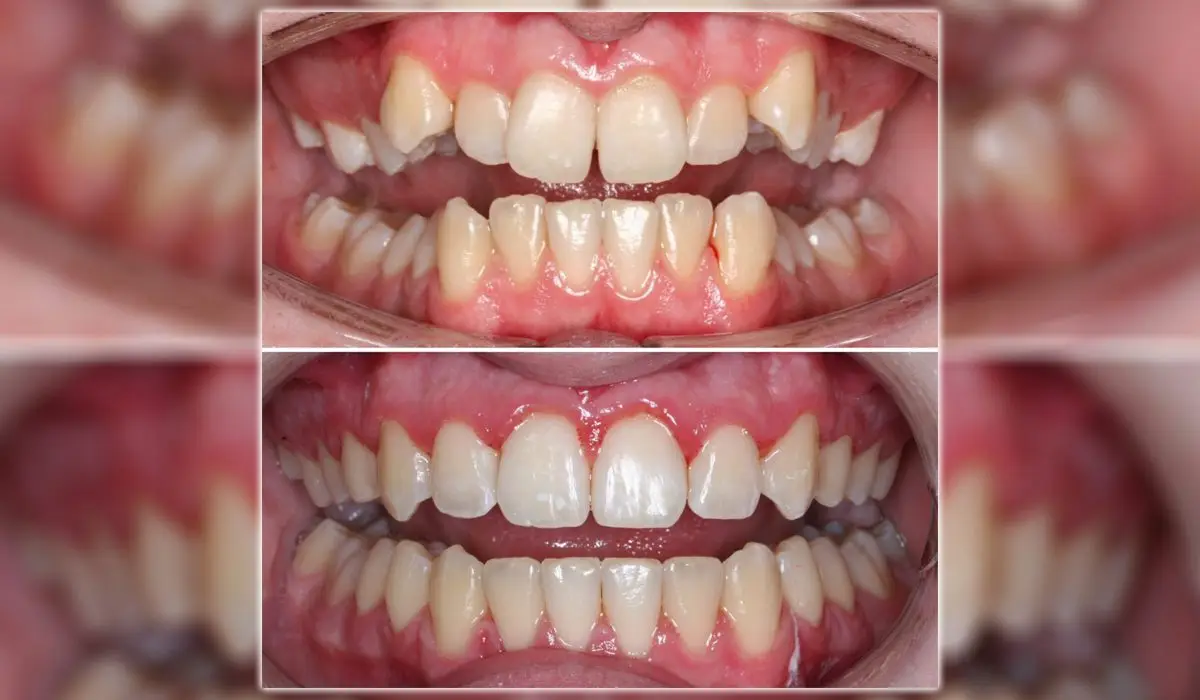Frequently Asked Questions About Invisalign: Everything You Required to Know
Frequently Asked Questions About Invisalign: Everything You Required to Know
Blog Article
Invisalign vs. Standard Braces: Which Alternative Is Right for You?
When taking into consideration orthodontic therapy, the choice between Invisalign and traditional dental braces offers numerous essential factors that merit mindful assessment. Invisalign offers a discreet choice with removable aligners, while traditional dental braces offer a more visible yet efficient option for extreme misalignment. Each option encompasses unique advantages and disadvantages connected to aesthetic appeals, convenience, therapy duration, and cost. Understanding these nuances is vital for making an informed choice that lines up with your individual choices and way of living. The question continues to be: which alternative will finest satisfy your orthodontic demands and assumptions?
Overview of Treatment Options

In comparison, traditional braces contain metal brackets and cords that are bound to the teeth. This approach applies continuous pressure with time to achieve positioning. While efficient for complex orthodontic issues, typical dental braces call for routine gos to for changes and can pose obstacles in preserving oral health due to the trouble of cleaning about braces and wires.
Both alternatives have their benefits, and the selection typically rests on certain oral conditions, way of life choices, and person compliance. Ultimately, consulting an orthodontic expert is essential for determining the most suitable treatment plan tailored to specific demands. Recognizing the nuances of each alternative can considerably influence the overall success of orthodontic treatment.
Visual Factors To Consider
A substantial factor affecting the option between Invisalign and traditional braces is the visual appeal each therapy offers. Invisalign aligners are crafted from clear plastic, making them essentially unnoticeable when put on.
On the other hand, conventional braces consist of steel braces and cords, which can be a lot more visible. While advancements in orthodontic modern technology have resulted in the development of smaller sized brackets and colored elastics, conventional braces still keep an even more conspicuous account. For some people, the exposure of dental braces might discourage them from looking for needed therapy.
Inevitably, the selection in between Invisalign and standard dental braces may depend upon personal preferences pertaining to looks. Individuals who focus on discretion commonly favor Invisalign, while those that are much less worried concerning visibility may choose traditional braces. Comprehending the aesthetic ramifications of each alternative is vital for making an informed choice that aligns with one's way of life and choices.
Convenience and Convenience

In terms of convenience, Invisalign aligners are detachable, read this post here enabling individuals to enjoy their favorite foods without limitation and maintain optimum dental hygiene. Cleaning and flossing are streamlined, site web as the aligners can be secured throughout these regimens, whereas standard braces require careful steering around cords and braces.
In addition, Invisalign's progressive system permits fewer orthodontic check outs. Individuals generally receive several collections of aligners simultaneously, which can improve the treatment procedure and decrease time spent in the orthodontist's chair. On the other hand, conventional dental braces require routine adjustments, making them much less hassle-free for those with hectic timetables. Invisalign. Generally, the convenience and benefit of Invisalign make it an enticing choice for lots of people looking for orthodontic treatment.
Therapy Period and Effectiveness
While both Invisalign and standard dental braces are effective in remedying oral imbalances, the period of treatment can vary dramatically between both options. Generally, Invisalign therapy can take anywhere from 12 to 18 months, depending on the complexity of the situation. The clear aligners work by slowly moving teeth right into their preferred positions, and normal follow-ups with an orthodontist assistance make certain progression continues to be on the right track.
On the other hand, conventional dental braces often call for a longer dedication, usually ranging from 18 months to three years. This results from their fixed nature and using brackets and cables, which can be extra reliable for serious imbalances and complex instances (Invisalign). The therapy effectiveness of typical dental braces is well-documented, as they enable for specific modifications and higher control over tooth activity
Ultimately, the selection in between Invisalign and traditional dental braces may rest on both the expected therapy duration and the specific oral problems handy. Consulting with an orthodontist is crucial, as they can supply customized suggestions based upon individual demands, making sure the selected technique aligns with preferred outcomes and timeframes.
Cost Comparison and Insurance Policy Options
Cost plays a significant duty in the decision-making procedure for people thinking about orthodontic treatment, whether choosing Invisalign or typical braces. On average, the cost of description Invisalign arrays from $3,000 to $8,000, while standard braces usually set you back between $2,000 and $6,000. Factors affecting these costs include the intricacy of the situation, the duration of treatment, and geographical place.
Insurance policy protection can significantly influence out-of-pocket expenses. Lots of dental insurance strategies give partial insurance coverage for orthodontic therapies, yet the specifics can differ commonly. It is vital for people to examine their insurance policy plans to establish the degree of insurance coverage for either option. Typically, standard dental braces may be a lot more frequently covered by insurance strategies compared to Invisalign, which some insurance firms classify as a cosmetic procedure.
Additionally, a number of orthodontic techniques provide versatile settlement strategies, making both therapy choices more easily accessible. Patients ought to make inquiries regarding prospective financing options and discount rates for in advance payments. Reviewing the complete cost, consisting of insurance coverage benefits and settlement strategies, is crucial for making a notified choice that lines up with both aesthetic preferences and budget plan considerations.

Conclusion
In summary, the selection between Invisalign and standard dental braces depends upon multiple aspects, including visual choices, convenience, therapy duration, and cost. Invisalign provides a very discreet, detachable choice that facilitates dental hygiene and dietary flexibility, while typical dental braces might be better for complex dental concerns and commonly come with a lower price factor. Inevitably, assessment with an orthodontist is necessary to examine individual circumstances and figure out one of the most ideal treatment option for attaining optimal oral alignment.
When thinking about orthodontic treatment, the selection between Invisalign and traditional braces presents a number of vital variables that warrant cautious evaluation.Comparing Invisalign and typical braces reveals distinctive treatment alternatives for orthodontic modification.While both Invisalign and traditional dental braces are effective in dealing with dental misalignments, the period of therapy can vary substantially in between the 2 choices.Expense plays a considerable function in the decision-making process for people considering orthodontic treatment, whether choosing for Invisalign or typical braces.In summary, the option in between Invisalign and typical dental braces hinges on multiple variables, including aesthetic preferences, convenience, treatment period, and cost.
Report this page